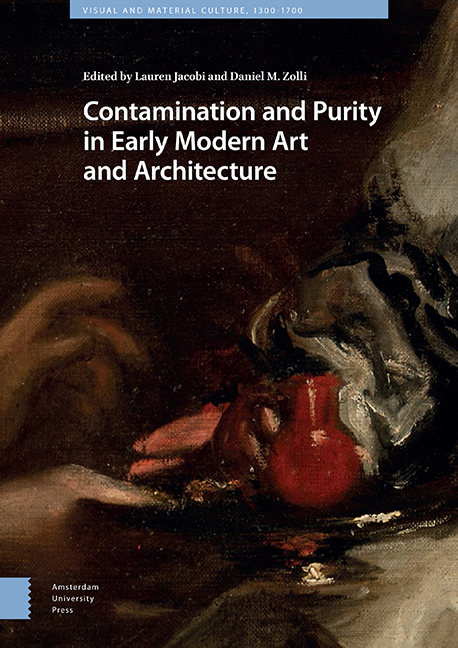Book contents
- Frontmatter
- Contents
- List of Illustrations
- Introduction: Contamination and Purity in Early Modern Art and Architecture
- 1 Generation and Ruination in the Display of Michelangelo’s Non-finito
- 2 The Sacrilege of Soot: Liturgical Decorum and the Black Madonna of Loreto
- 3 Sedimentary Aesthetics
- 4 ‘Adding to the Good Silver with Other Trickery’ : Purity and Contamination in Clement VII’s Emergency Currency
- 5 Tapestry as Tainted Medium: Charles V’s Conquest of Tunis
- 6 Bruegel’s Dirty Little Atoms
- 7 Leakage, Contagion, and Containment in Early Modern Venice
- 8 Contamination, Purification, Determinism: The Italian Pontine Marshes
- 9 Colonial Consecrations, Violent Reclamations, and Contested Spaces in the Spanish Americas
- 10 Contamination | Purification
- Index
4 - ‘Adding to the Good Silver with Other Trickery’ : Purity and Contamination in Clement VII’s Emergency Currency
Published online by Cambridge University Press: 27 May 2021
- Frontmatter
- Contents
- List of Illustrations
- Introduction: Contamination and Purity in Early Modern Art and Architecture
- 1 Generation and Ruination in the Display of Michelangelo’s Non-finito
- 2 The Sacrilege of Soot: Liturgical Decorum and the Black Madonna of Loreto
- 3 Sedimentary Aesthetics
- 4 ‘Adding to the Good Silver with Other Trickery’ : Purity and Contamination in Clement VII’s Emergency Currency
- 5 Tapestry as Tainted Medium: Charles V’s Conquest of Tunis
- 6 Bruegel’s Dirty Little Atoms
- 7 Leakage, Contagion, and Containment in Early Modern Venice
- 8 Contamination, Purification, Determinism: The Italian Pontine Marshes
- 9 Colonial Consecrations, Violent Reclamations, and Contested Spaces in the Spanish Americas
- 10 Contamination | Purification
- Index
Summary
Abstract
In early modern sites of smithing and minting, the point of flux – when solid metal became liquid – was always opportune for contamination and deceit. The reputations of metalworkers could turn on it. In chaotic, unregulated circumstances, the handling of molten gold and silver became even more suspect. This essay considers purity and contamination with respect to two acts of metallic transformation during the Sack of Rome in 1527, when papal treasures were melted down to consolidate financial assets and produce emergency currency. In addition to the expected anxieties surrounding the fineness of gold and silver in these circumstances, the two events also suggest an alternate conception of metallic purity that takes into account metal's protean transit between forms.
Keywords: currency, minting, siege, Sack of Rome, Benvenuto Cellini, Pope Clement VII
During the Sack of Rome in 1527, soldiers in the employ of Emperor Charles V plundered the city, looting valuables from homes and institutions, and ransoming private citizens for their life savings. One Swabian commander, reflecting back on his participation in this event years later, remembered capturing Pope Clement VII and his cardinals in the Castel Sant’Angelo with the brusque and economical line ‘they made a big fuss and cried a lot; we became rich.’ He and his soldiers profited financially because Clement VII eventually agreed to pay the enormous sum of 400,000 ducats in order to secure his freedom. Faced with an extreme cash shortage, raising the promised funds meant liquidating assets held in the papal treasury. Liquidation is used here not in the modern financial sense of selling off holdings, but rather as the actual physical act of melting down precious metal objects and turning the resulting material into coins. Available gold and silver objects – likely including ecclesiastical plate and papal ornaments – were transformed into ducats, half-ducats, and quarter-ducats (Figs. 4.1–3).
The coins produced during Clement's captivity are classified in modern numismatic terminology as emergency currency, money intended for temporary use that is made outside of standard minting procedures. In the sixteenth century, emergency coins were most often struck during military conflicts, in the context of sieges or during campaigns. Among the most well-known examples of emergency coins, Clement's 1527 ducats are sometimes misidentified as the first objects of their kind.
- Type
- Chapter
- Information
- Contamination and Purity in Early Modern Art and Architecture , pp. 157 - 182Publisher: Amsterdam University PressPrint publication year: 2021

